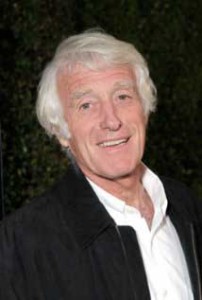
The latest movie by award-winning director of photography, Roger Deakins, is Unbroken, an ambitious World War II biopic helmed by Angelina Jolie in only her second time in the director’s chair. “The hardest thing for Angie and certainly for me as the cinematographer was to make it all feel and look like the same movie and not like little bits put together,” Deakins said.
The $50 million Warner Bros. film, set for release on Christmas Day, is the story of Louie Zamperini, a Southern California runner who competed in the same 1936 Berlin Olympics that made Jesse Owens famous. Zamperini became a bomber pilot after Pearl Harbor, was shot down over the Pacific and spent almost seven weeks on a raft in shark-infested waters, only to be rescued by the Japanese and interned in three harsh prisoner of war camps. It is based on the best-seller by Laura Hillenbrand, Unbroken: a World War II Story of Survival, Resilience and Redemption. Zamperini died last July at the age of 97. (Touchingly, Jolie managed to show him some scenes from the film before he passed away.)
Making the movie, shot in Australia at numerous locations, the DP and the director faced the challenge of keeping the film integrated throughout its many episodes. “The film feels epic, but it’s actually a small film in a way—it didn’t have a huge budget—and it basically all revolves around this one character, Zamperini,” noted Deakins. “The game plan was to keep the focus on this guy and all he went through.”
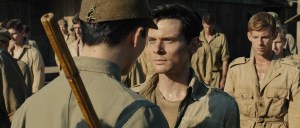
Zamperini, played by Jack O’Connell, is indeed front and center in each chapter of the plot and Deakins, with his elegant cinematography, captured the distinct visual atmosphere of each segment, while creating a consistent overall look that knit the film together. That wasn’t easy. Aside from aesthetic considerations, Deakins and Jolie had to contend with maddeningly complicated logistics to reach that objective, not the least of which was the necessity to shoot the movie backwards.
The early scenes depict a small-town suburb of Los Angeles in the late 1920s where a young, bumptious kid is transformed into a fiercely competitive runner. This is followed by the Olympics where Zamperini, though he fails to win the 5000 meter race, finishes the final lap at a record-breaking pace and attracts the attention of Adolph Hitler. For Deakins, the goal was to create a look that conveyed the historical setting without getting too fussy—no Leni Riefenstahl bombast.
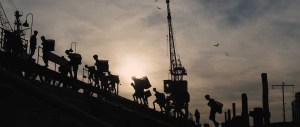 The highlight of the next part shows Zamperini, as a bombardier, engaged in a tense air fight that ends with the plane plunging into the wide-open Pacific. While there’s some impressive external footage, the scene mostly takes place in the big glassed-in cockpit of a B-24. “We felt it was important to be with the character and show what it would be like and feel like to be inside the plane, not make it into a videogame of planes flying at each other.”
The highlight of the next part shows Zamperini, as a bombardier, engaged in a tense air fight that ends with the plane plunging into the wide-open Pacific. While there’s some impressive external footage, the scene mostly takes place in the big glassed-in cockpit of a B-24. “We felt it was important to be with the character and show what it would be like and feel like to be inside the plane, not make it into a videogame of planes flying at each other.”
A full-size version of the airplane and a second construction of the full-size fuselage and cockpit of the aircraft were used to film. “Both were on gimbals suspended in the air so we could look down through the bomb bay doors and the fuselage,” said the DP. “We had to have the two plane replicas quite a way off the ground to get those shots.”
Then there’s a long sequence in the raft with Zamperini and two other survivors of the crash. It was filmed both in the open ocean, a half-dozen miles offshore with the raft anchored to a nearby ship, and in a contained tank where waves were generated. For a scene when a major storm blows up, Deakins filmed the raft raised on a gimbal to let it rotate and twist around while it was being drenched with water. CGI was used to further augment the effect. One of the trickiest parts to film has the starving characters first catch and eviscerate an albatross and then start hauling in a few big fish by hand, including a shark. What appears on the screen is an amazingly convincing composite of real and plastic fish, an albatross puppet, a dead albatross and more CGI.
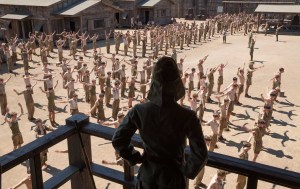 Once captured by the Japanese, Zamperini spends time at three prisoner of war camps each with a distinct look and atmosphere. In each he encounters his nemesis, a sadistic Japanese commandant known as the Bird who comes up with one new torture after another. Tense face-to-face, eyeball-to-eyeball confrontations take place. “Framing was what I concentrated on,” Deakins explained. “The most important thing was to balance the characters within the frame.”
Once captured by the Japanese, Zamperini spends time at three prisoner of war camps each with a distinct look and atmosphere. In each he encounters his nemesis, a sadistic Japanese commandant known as the Bird who comes up with one new torture after another. Tense face-to-face, eyeball-to-eyeball confrontations take place. “Framing was what I concentrated on,” Deakins explained. “The most important thing was to balance the characters within the frame.”
A powerful drama unfolds toward the end of the movie. Zamperini is made to lift an enormous heavy plank over his head, in a visual that has Christ-like resonance. For Deakins, getting the angle of the sun correct to create the proper lighting effect was the goal. “The trick was gauging the travel of light during the shot,” he noted. “I wanted Louie holding the plank looking into the sun as it is setting, and the sun showing up in his face. We’d set up the location, and when the angle of the sun hit the right angle of light, I’d start to shoot.”
A daunting challenge was the need to shoot the film in reverse order. The last-to-first scene shooting schedule was required because of major changes in O’Connell’s weight and physique, along with those of other actors, as the film progressed. The movie begins with O’Connell looking robust and muscular as he trains for the Olympics. On the raft after he’s shot down, he and the other two survivors start out looking fairly fit but become leaner as the weeks go by. In the prisoner of war camps, not only does O’Connell look emaciated, so do the other prisoners.
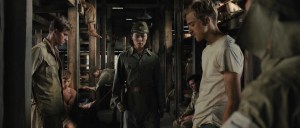 “You couldn’t wait for the actors to lose weight during the shoot because that would take impossibly long and wreck the schedule and the budget,” Deakins pointed out. “So they took off many pounds during prep, and then when the holidays came, they could go home and gain weight feasting on Christmas dinners and all the food they wanted.”
“You couldn’t wait for the actors to lose weight during the shoot because that would take impossibly long and wreck the schedule and the budget,” Deakins pointed out. “So they took off many pounds during prep, and then when the holidays came, they could go home and gain weight feasting on Christmas dinners and all the food they wanted.”
That required the first scenes to be shot in the POW camps and on the raft when the actors look the thinnest. And even the raft sequence had to be done backwards because the characters looked healthier at the start and then became progressively thinner. “So we had to shoot the whole film in reverse, which made it particularly hard for me to maintain a sense of continuity, let alone for Angie as director to get a handle on Zamperini’s evolution and journey as a character when we were shooting back to front,” said the DP.
What was it like working with Jolie? “She is a great collaborator,” said Deakins. “She has a very clear notion of where she wants to go, is very well prepared and she also really listens to other people’s ideas.”
Deakins has been nominated for an Academy Award for best cinematography 11 times including last year for Prisoners. Other Oscar nods came for The Shawshank Redemption 20 years ago, and for many films directed by the Coen brothers including Fargo, No Country for Old Men and True Grit. He won the American Society of Cinematographers’ award for best motion picture cinematography three times for The Shawshank Redemption, The Man Who Wasn’t There and Skyfall. In 2010 he received the ASC’s Lifetime Achievement Award.





